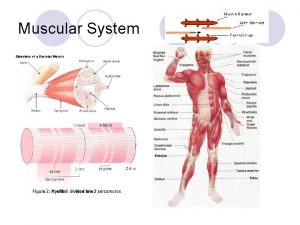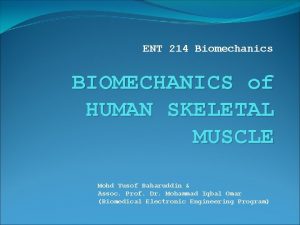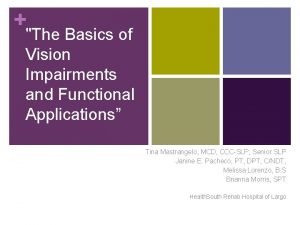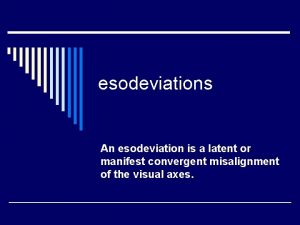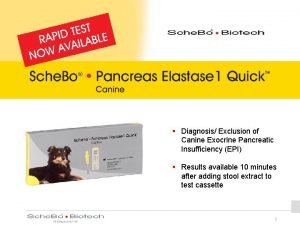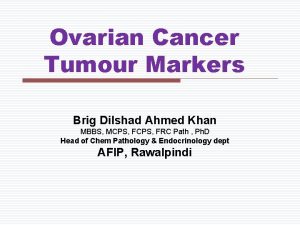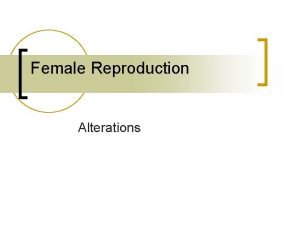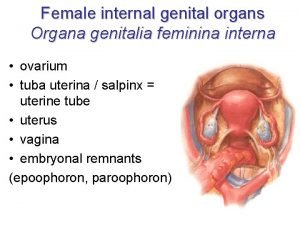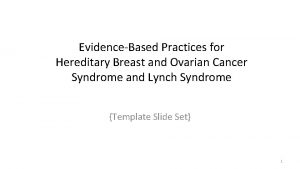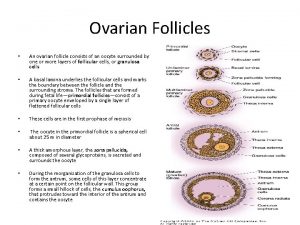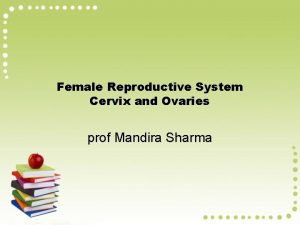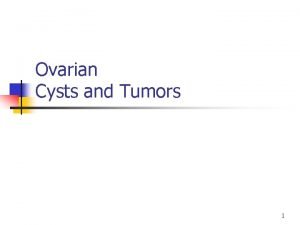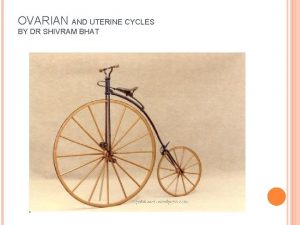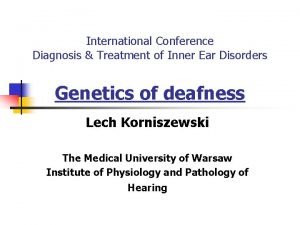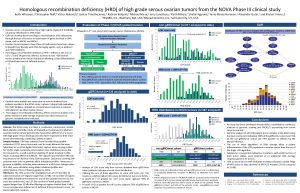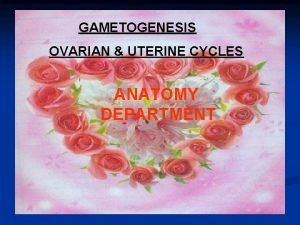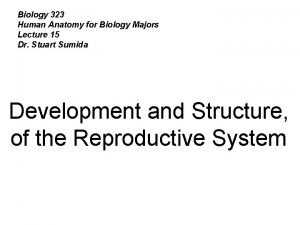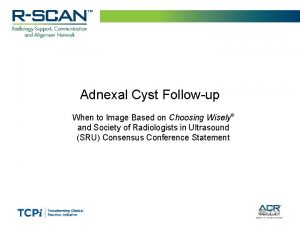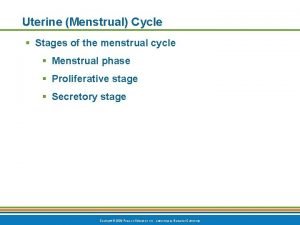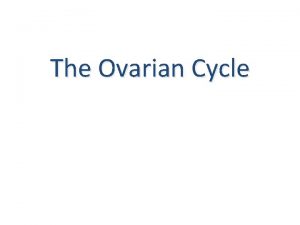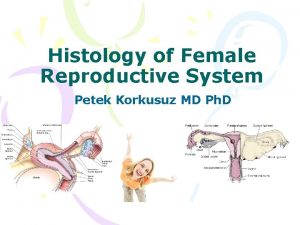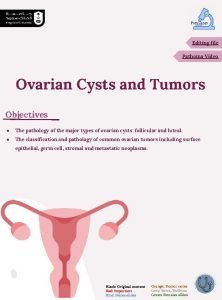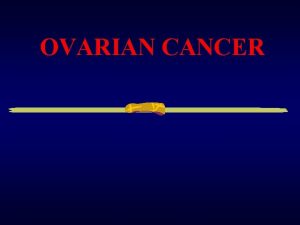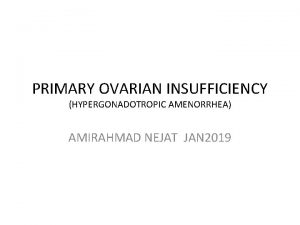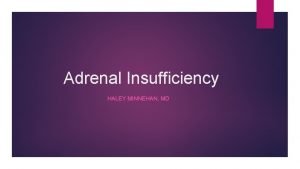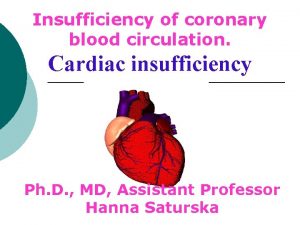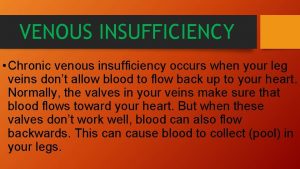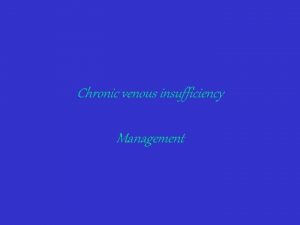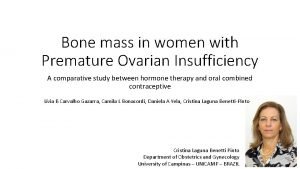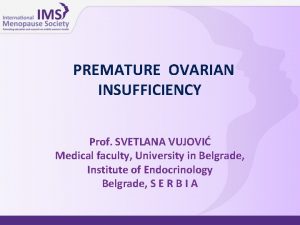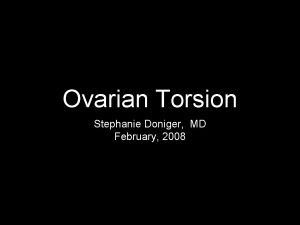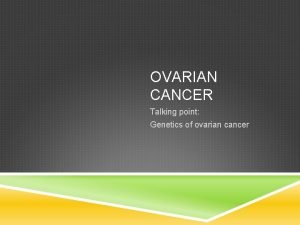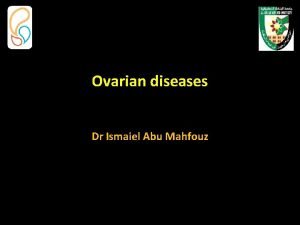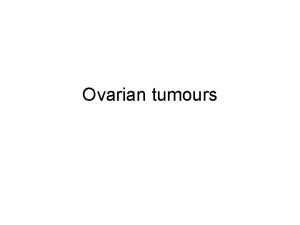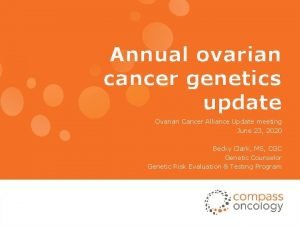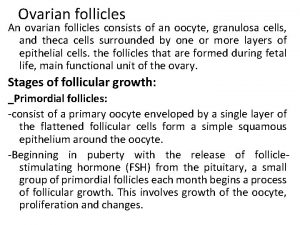IN THE NAME OF GOD Primary ovarian insufficiency











































































- Slides: 75

IN THE NAME OF GOD

Primary ovarian insufficiency (POI) �POI is a rare but important cause of sex steroid deficiency and infertility in premenopausal women. �POI is characterized by menopausal levels of FSH and absent or irregular menstrual cycles before the age of 40 years. �Because the average of natural menopause is 50– 51 years, women exhibiting these findings after age 40 but before age 45 are said to have early menopause. � Fertility and Sterility® Vol. 106, No. 7, December 2016 0015 -0282/$36. 00 � Hormone replacement therapy in young women with primary ovarian insufficiency and early

Primary ovarian insufficiency (POI) �Infertility �Bothersome menopausal symptoms �Decreased bone density �Increased risk of fractures �Early progression of cardiovascular disease �psychologic impact that may include � depression, anxiety, and decreased perceived psychosocial support �potential early decline in cognition �Dry eye syndrome �Increased risk of type 2 diabetes mellitus (T 2 DM) or pre-DM � Fertility and Sterility® Vol. 106, No. 7, December 2016 0015 -0282/$36. 00

Screening before pregnancy for women with Turner syndrome. Consultation with cardiologist specializing in congenital heart disease Echocardiogram Electrocardiogram Cardiac magnetic resonance imaging (MRI) scan Assessment for hypertension TSH, free thyroxine (T 4), antithyroid antibodies Fasting glucose and hemoglobin A 1 c Liver function testing with hepatic ultrasound if abnormal Renal ultrasound Renal function testing if renal anomaly or

In vitro fertilization (IVF) �donated oocytes �Women with Turner syndrome are not recommended to become pregnant even with donor oocytes because of the high rates of mortality during pregnancy resulting from aortic aneurysm rupture. * �Pregnancy should be avoided in Turner syndrome. * � *=Obstet Gynecol Clin N Am 42 (2015) 153– 161 � Premature Ovarian Failure Clinical Presentation and Treatment

Management of fertility and pregnancy in women with Turner syndrome �should undergo a complete medical evaluation before attempting pregnancy, with particular attention paid to cardiovascular and renal function, as recommended by the American Society of Reproductive Medicine (ASRM). Because of this, the ASRM considers Turner syndrome a relative contraindication for pregnancy but an absolute contraindication if there is a documented cardiac anomaly. UPTodate Nov 28, 2016

Cardiovascular Disease

Cardiovascular Disease �Evidence points to estrogen deficiency as a driver of increased CVD risk associated with POI. �Women who experienced menopause before age 45 have a higher risk of CHD, cardiovascular mortality, and overall mortality compared with women who experienced menopause after age 50(meta-analysis) � Fertility and Sterility® Vol. 106, No. 7, December 2016 0015 -0282/$36. 00

Overall mortality �Overall mortality was also found to be increased in women with POF. �Ischemic heart disease, stroke, and cancers were the most common causes for mortality in this study. � Fertility and Sterility® Vol. 106, No. 7, December 2016 0015 -0282/$36. 00 � Hormone replacement therapy in young women with primary ovarian insufficiency and early menopause

Cardiovascular disease risk �A 2. 1 - fold increased risk for ischemic heart disease (Danish Nurse Cohort study) � Obstet Gynecol Clin N Am 42 (2015) 153– 161 � Premature Ovarian Failure Clinical Presentation and Treatment

Cardiovascular disease risk �Women with s. POI have reduced vascular endothelial function, an early sign of atherosclerosis. �Women with POI, regardless of the cause, have increased risks of CVD and ischemic stroke.

�Treatment with the use of HRT for 6 months significantly improved endothelial function in these women. � Fertility and Sterility® Vol. 106, No. 7, December 2016 0015 -0282/$36. 00 � Hormone replacement therapy in young women with primary ovarian insufficiency and early menopause

CVD risk assessments and risk reduction �These include: � lifestyle modifications �management of lipid levels and �hypertension, and �early initiation of physiologic HRT � Fertility and Sterility® Vol. 106, No. 7, December 2016 0015 -0282/$36. 00 � Hormone replacement therapy in young women with primary ovarian insufficiency and early menopause

MANAGEMENT of POF

HRT IN POF �The first goal of the management→Prevention of consequences of hypoestrogenemia �HRT as soon as POF is diagnosed

HORMONE REPLACEMENT THERAPY �The Women's Health Initiative study involved menopausal women who averaged 63 years of age. (hormone ‘‘extension) �The results should not be applied to young women with POI or early menopause. (hormone replacement) � Fertility and Sterility® Vol. 106, No. 7, December 2016 0015 -0282/$36. 00

HORMONE REPLACEMENT THERAPY �Unfortunately, a recent study showed that more than one-half (52%) of young women with POI either never take HRT, start HRT many years after their diagnosis, and/or discontinue HRT use before age 45. � Fertility and Sterility® Vol. 106, No. 7, December 2016 0015 -0282/$36. 00 � Hormone replacement therapy in young women with primary ovarian insufficiency and early menopause

Transdermal or Transvaginal E 2 therapy �The weight of evidence now favors transdermal or transvaginal E 2 therapy as the first line of HRT for young women with POI or early menopause. � Fertility and Sterility® Vol. 106, No. 7, December 2016 0015 -0282/$36. 00 � Hormone replacement therapy in young women with primary ovarian insufficiency and early

Transdermal patch and the vaginal ring �The transdermal patch and the vaginal ring that deliver 0. 100 mg E 2 per day �These formulations mimic the daily ovarian production rate of E 2 and achieve average serum E 2 levels of 100 pg/m. L; this is the average level that women with normal ovarian function experience across the menstrual cycle. � Fertility and Sterility® Vol. 106, No. 7, December 2016 0015 -0282/$36. 00

Oral E 2 �An equivalent dose of oral E 2 is also effective replacement; however, the transdermal and transvaginal routes of administration deliver hormone directly into the circulation, which avoids complications associated with the firstpass effect on the liver when estrogen is given orally.

Oral E 2 �transdermal estradiol or vaginal ring (100 mcg daily)= 2 mg of oral micronized estradiol= 1. 25 mg of oral conjugated equine estrogen= 10 mcg of oral ethinyl estradiol? ? ? � UPTODATE

Risk of venous thromboembolism �oral estrogen > transdermal estrogen �In the multicenter ESTHER study performed in postmenopausal women, the odds ratio (OR) for venous thromboembolism in women using oral estrogens was 4. 2 (95% CI 1. 5– 11. 6) compared with 0. 9 (95% CI 0. 4– 2. 1) in women using transdermal estrogen preparations. * � Estrogen and Thromboembolism Risk(ESTHER) � *Fertility and Sterility® Vol. 106, No. 7, December 2016 0015 -0282/$36. 00 � *Hormone replacement therapy in young women with primary ovarian insufficiency and early menopause

Transdermal HRT �In addition, unlike oral estrogens, transdermal HRT does not adversely alter cardiovascular disease or thromboembolic risk markers. � Fertility and Sterility® Vol. 106, No. 7, December 2016 0015 -0282/$36. 00 � *Hormone replacement therapy in young women with primary ovarian insufficiency and early menopause

venous thromboembolism risk �In women with underlying obesity or clotting disorders, the venous thromboembolism risk associated with oral estrogen is heightened further, to 5– 8 times the risk seen in nonusers or users of transdermal estrogen preparations. � Fertility and Sterility® Vol. 106, No. 7, December 2016 0015 -0282/$36. 00 � *Hormone replacement therapy in young women with primary ovarian insufficiency and early menopause

�Also, relative risk of stroke is increased in postmenopausal women prescribed oral estrogen versus transdermal estrogen as part of their hormone therapy regimen. � Fertility and Sterility® Vol. 106, No. 7, December 2016 0015 -0282/$36. 00 � *Hormone replacement therapy in young women with primary ovarian insufficiency and early menopause

Risk associated with oral estrogen compared with transdermal estrogen use Risk oral estrogen associated ↑↑ stroke ↑↑ VTE first-pass effect + on the liver cardiovascular + disease transdermal estrogen ↑ ↑ – –

Contraceptive steroid hormone agents �have been associated with increased risk of: �Thromboembolism �Stroke �Subarachnoid hemorrhage �worsening cardiometabolic risk, including increase in �blood pressure and �unfavorable lipid profiles � Fertility and Sterility® Vol. 106, No. 7, December 2016 0015 -0282/$36. 00 � *Hormone replacement therapy in young women with primary ovarian insufficiency and early

Prevention of consequences of hypoestrogenemia �HRT (postmenopausal women) �However, women with POF may require higher doses of estrogen than postmenopausal women �Oral contraceptives (OCPs) present a good alternative to postmenopausal HRT regiments. �OCPs generally have 2 -fold to 4 -fold higher estrogen content than postmenopausal HRT regiments. �patients’ satisfaction � Obstet Gynecol Clin N Am 42 (2015)

Drosperinone-containing formulations �In particular, -containing formulations are associated with an approximately twofold increased risk of venous thromboembolism and arterial thrombotic events, including acute myocardial infarction and stroke � Fertility and Sterility® Vol. 106, No. 7, December 2016 0015 -0282/$36. 00 � *Hormone replacement therapy in young women with primary ovarian insufficiency and

1 -week ‘‘pill-free’’ period �Oral contraceptives typically have a 1 -week ‘‘pill-free’’ period each month (or every 3 months with 3 -month preparations), resulting in a regular temporary estrogen-deficient state. � Fertility and Sterility® Vol. 106, No. 7, December 2016 0015 -0282/$36. 00 � *Hormone replacement therapy in young women with primary ovarian insufficiency and early menopause

oral contraceptives � 1 -week ‘‘pill-free’’ period(each month or every 3 months with 3 -month preparations)→regular temporary estrogen-deficient state→return of unwanted menopausal symptoms(some) � Fertility and Sterility® Vol. 106, No. 7, December 2016 0015 -0282/$36. 00 � *Hormone replacement therapy in young women with primary ovarian insufficiency and early menopause

�A recent randomized controlled cross- over trial in young women with POI compared the cardiovascular effects of treatment with transdermal E 2 plus cyclic progestin versus treatment with a combination oral contraceptive � Langrish JP, Mills NL, Bath LE, Warner P, Webb DJ, Kelnar CJ, et al. Cardiovascular � effects of physiological and standard sex steroid replacement regimens

� Compared with the oral contraceptive, 12 months of transdermal physiologic HRT resulted in significantly lower blood pressure, better renal function, and reduced activation of the renin-angiotensin-aldosterone system. � This evidence suggests that transdermal physiologic HRT is superior to the combined oral contraceptive in promoting cardiovascular health in young women with POI. � Langrish JP, Mills NL, Bath LE, Warner P, Webb DJ, Kelnar CJ, et al. Cardiovascular � effects of physiological and standard sex steroid replacement regimens � in premature ovarian failure. Hypertension 2009; 53: 805– 11 .



Progestins �Most women with POI have an intact uterus, so the recommended hormone replacement is both estrogen and progestin. �Cyclical progestin is recommended for endometrial protection. � Fertility and Sterility® Vol. 106, No. 7, December 2016 0015 -0282/$36. 00 � *Hormone replacement therapy in young women with primary ovarian insufficiency and early menopause

The NIH study of HRT in POI �transdermal E 2 (100 µg/d) with oral medroxyprogesterone acetate (10 mg/d for 12 days per month). �MPA (fully induce secretory endometrium in conjunction) �Cycling progestin courses given less frequently than monthly (termed ‘‘long-cycle HRT’’) is not recommended, because that approach increases the risk of endometrial hyperplasia and potentially of endometrial cancer

Medroxyprogesterone acetate �Is not derived from T and is a 21 -carbon ‘‘pure’’ progestin, compared with the 19 norprogestins which may have associated androgenic effects � Fertility and Sterility® Vol. 106, No. 7, December 2016 0015 -0282/$36. 00 � *Hormone replacement therapy in young women with primary ovarian insufficiency and early menopause

micronized P �The Postmenopausal Estrogen/Progestin Interventions (PEPI) Group did not investigate the efficacy of oral micronized P to effectively induce secretory endometrium in conjunction with a full replacement dose of estrogen. �Pharmacokinetics of oral micronized P � Fertility and Sterility® Vol. 106, No. 7, December 2016 0015 -0282/$36. 00 � *Hormone replacement therapy in young women with primary ovarian insufficiency and early menopause

�There is insufficient evidence to determine if medroxyprogesterone acetate and micronized P therapy differ significantly regarding association with the development of breast cancer. �Women who can not tolerate medroxyprogesterone acetate may be prescribed micronized P but should be monitored for endometrial suppression on at least an annual basis. � Fertility and Sterility® Vol. 106, No. 7, December 2016 0015 -0282/$36. 00 � *Hormone replacement therapy in young women with primary ovarian insufficiency and early

Cardiovascular risk and progestin �in combination with E 2, both medroxyprogesterone acetate and micronized P improve cardiovascular risk markers, including serum high-density lipoprotein (HDL) and lowdensity lipoprotein levels, blood pressure, and fibrinogen levels. �improving HDL levels(micronized P may be superior) �In the Kronos Early Estrogen Prevention Study (KEEPS) � Fertility and Sterility® Vol. 106, No. 7, December 2016 0015 -0282/$36. 00

Risk associated with medroxyprogesterone acetate compared with progestin Risk associated micronized P medroxyprogesterone acetate breast cancer insufficient evidence Improving HDL levels ++ + venous thromboembolism does not alter risk does not alter

Norpregnane derivatives �However, the use of norpregnane derivatives (nomegestrol acetate, promegestone), which are rarely used in the U. S. , increases venous thromboembolism risk up to fourfold. � Fertility and Sterility® Vol. 106, No. 7, December 2016 0015 -0282/$36. 00 � *Hormone replacement therapy in young women with primary ovarian insufficiency and early menopause

Testosterone �In premenopausal women, endogenous T production is 300 micg daily, with 50% produced by the adrenal glands and 50% by the ovaries �Currently, there is insufficient evidence to recommend the diagnosis or treatment of T deficiency in women, even those with POI. �Taken together, and given their deficient ovarian androgen production, it appears likely that with more research, T replacement in physiologic doses may ultimately prove to be of benefit to women with POI. � Fertility and Sterility® Vol. 106, No. 7, December 2016 0015 -0282/$36. 00 � *Hormone replacement therapy in young women with primary ovarian insufficiency and early

Benefit of physiologic T replacement �no benefit on: �quality of life �self-esteem �Mood �In another study improvements in: �BMD �cardio metabolic risk factors �neurocognitive measures �Libido �overall quality of life � Fertility and Sterility® Vol. 106, No. 7, December 2016 0015 -0282/$36. 00 � *Hormone replacement therapy in young women with primary ovarian insufficiency and early menopause

Dehydroepiandrosterone �Taken together, however, the findings regarding fertility- enhancing effects of DHEA in women with ovarian insufficiency are still controversial and show minimal clinical benefit at most. � Fertility and Sterility® Vol. 106, No. 7, December 2016 0015 -0282/$36. 00 � *Hormone replacement therapy in young women with primary ovarian insufficiency and early menopause

SPECIAL POPULATIONS

Turner Syndrome �women with Turner syndrome, 90% develop POI many girls with Turner syndrome require estrogen replacement for induction of puberty and menarche, to promote bone accrual early in life and later, and to promote maintenance of bone density

Hormonal Substitution Therapy in Hypogonadism Girls With a firmly established diagnosis of hypogonadism (e. g. , girls with 45, X gonadal dysgenesis), begin hormonal substitution therapy at 12 -13 yr of age Goal: to approximate normal adolescent development Initial therapy: ethinyl estradiol 5 mg? by mouth or conjugated estrogen 0. 3 mg (or less) by mouth daily for 4 -6 mo or preferably estradiol transdermally After 6 mo of therapy (or sooner if breakthrough bleeding occurs), begin cyclic therapy: Estrogen: first 21 days of month Progestagen: (e. g. , medroxyprogesterone acetate 5 mg PO) 12 th to 21 st day of month Gradually increase dose of estrogen over next 2 -3 yr to conjugated estrogen 0. 6 -1. 25 mg or ethinyl estradiol 10 -20 mg daily for first 21 days of month or estradiol patch

�The preferred HRT regimen for women with Turner syndrome is 100 mg transdermal or transvaginal E 2 daily with 10 mg cyclic medroxyprogesterone acetate daily for 12 days per month. This regimen is clinically available, supported by the best evidence, and currently best mimics physiologic patterns of normal ovarian function. � Fertility and Sterility® Vol. 106, No. 7, December 2016 0015 -0282/$36. 00 � *Hormone replacement therapy in young women with primary ovarian insufficiency and early menopause

Breast and Ovarian Cancer �HRT is considered to be unsafe, and alternate measures should be used to reduce the risks and symptoms associated with POI. These may include: � 1) low-dose vaginal estrogens or selective estrogen receptor modulators for vulvovaginal atrophy associated with estrogen deficiency � 2) healthy lifestyle changes to reduce cardiometabolic risk � 3) calcium and vitamin D supplementation and regular weight-bearing exercise to promote bone health � 4) possibly antidepressants and/or psychotherapy if indicated for depressed mood. � Fertility and Sterility® Vol. 106, No. 7, December 2016 0015 -0282/$36. 00 � *Hormone replacement therapy in young women with primary ovarian insufficiency and early

Breastfeeding �According to FDA-approved drug labels, neither E 2 in oral or transdermal forms nor hormonal contraceptives are recommended to be used during breastfeeding. �Small amounts of hormone are transmitted via breast milk, which may cause jaundice or breast enlargement in the neonate. �Additionally, estrogen use may interfere with lactation by decreasing the quantity and quality of breast milk. �A nursing mother with POI should be advised not to use HRT, including contraceptive steroids, until she has completely weaned her child. � Fertility and Sterility® Vol. 106, No. 7, December 2016 0015 -0282/$36. 00 � *Hormone replacement therapy in young women with primary ovarian insufficiency and early menopause

After Age 50 �The mean age of natural menopause is 50 ± 4 years �How to discontinue HRT? (individualized) �For example, women with a strong family history of breast cancer might decide to stop HRT at age 45 years. �Strong family history of osteoporosis or cardiovascular disease might wish to continue HRT until age 55 years. � Fertility and Sterility® Vol. 106, No. 7, December 2016 0015 -0282/$36. 00 � *Hormone replacement therapy in young women with primary ovarian insufficiency and early menopause

After Age 50 �Women with POI can be reassured that lower postmenopausal doses of HRT, when initiated within 10 years after menopause onset, have been associated with overall favorable risk-benefit profiles, including decreases in menopausal symptoms, fractures, CVD, type II diabetes mellitus, and mortality. � Fertility and Sterility® Vol. 106, No. 7, December 2016 0015 -0282/$36. 00 � *Hormone replacement therapy in young women with primary ovarian insufficiency and early

HRT in young women with surgical primary ovarian insufficiency �Most bilateral oophorectomies occur at the time of hysterectomy and most hysterectomies occur between ages 35 and 45 years, with more than half of all hysterectomies in women aged 45 years or younger

HRT in young women with surgical primary ovarian insufficiency �The adverse effects of prophylactic oophorectomy are hormone deficiencyrelated symptoms �These effects are similar to women who develop POI by other mechanisms. �However, in Surgical POI symptoms are more sudden in onset and consequences can be more severe. � Hormone replacement therapy in young women with surgical primary ovarian insufficiency � Fertility and Sterility® Vol. 106, No. 7, December 2016 0015 -0282/$36. 00

�Before 2002 >90% of women used estrogen therapy (ET) after bilateral salpingo-oophorectomy. �At present, the figure has declined to <10%. �Nevertheless, fear of taking any kind of hormone therapy (HT) is pervasive despite the evidence for the safety and efficacy of ET. � Hormone replacement therapy in young women with surgical primary ovarian insufficiency � Fertility and Sterility® Vol. 106, No. 7, December 2016 0015 -0282/$36. 00

menopausal symptoms �Women who develop surgical POI experience more severe and more frequent menopausal symptoms than women who experience natural menopause. �symptoms occur almost immediately and can persist for decades. Hormone replacement therapy in young women with surgical primary ovarian insufficiency � Fertility and Sterility® Vol. 106, No. 7, December 2016 00150282/$36. 00

Menopausal symptoms � Untreated, symptoms, such as: � hot flashes � sleep disturbance � fatigue � decreased sexual desire � anxiety and depressed mood Impaired cognition � impaired short-term memory � dementia � Often have a major impact on quality of life, capacity to function, and disease risk � Hormone replacement therapy in young women with surgical primary ovarian insufficiency � Fertility and Sterility® Vol. 106, No. 7, December 2016 0015 -0282/$36. 00

Hot flashes �are a state of vasomotor instability during which arterial flow is affected by surging levels of epinephrine and norepinephrine. �Vasodilation occurs in the skin as core blood flow shunts to the periphery. �Coronary artery constriction during hot flashes can occur with >30% of women experiencing chest pressure or pain during a severe episode � Hormone replacement therapy in young women with surgical primary ovarian insufficiency � Fertility and Sterility® Vol. 106, No. 7, December 2016 0015 -0282/$36. 00

Vaginal dryness �Vaginal dryness signals decreased genital blood flow and cell loss eventuating in genital atrophy and the urogenital syndrome of menopause. � Hormone replacement therapy in young women with surgical primary ovarian insufficiency � Fertility and Sterility® Vol. 106, No. 7, December 2016 0015 -0282/$36. 00

Following bilateral oophorectomy risk �all-cause mortality (28%) �coronary heart disease (33%)* �stroke (62%) �cognitive impairment (60%) �Parkinsonism (80%) �osteoporosis and bone fractures (50%) �Sexual dysfunction (40%– 110%) �and, possibly, glaucoma � Hormone replacement therapy in young women with surgical primary ovarian insufficiency � Fertility and Sterility® Vol. 106, No. 7, December 2016 0015 -0282/$36. 00

Starting ET at the time of oophorectomy �Perhaps most important, the Mayo Clinic study indicates that starting ET at the time of oophorectomy and continuing until at least the age of natural menopause (ages 51– 52 years) significantly reduces most, but not all, of the increased risks seen in untreated women. � Hormone replacement therapy in young women with surgical primary ovarian insufficiency � Fertility and Sterility® Vol. 106, No. 7, December 2016 0015 -0282/$36. 00

Surges in catecholamine levels �Estrogen modulation of catecholamine release helps to prevent coronary constriction, whereas E withdrawal may trigger arterial instability and spasm. �These surges have been associated with �vasomotor instability �coronary spasm �myocardial infarction, and mortality � Hormone replacement therapy in young women with surgical primary ovarian insufficiency � Fertility and Sterility® Vol. 106, No. 7, December 2016 0015 -0282/$36. 00

BONE �At 6 years after oophorectomy, almost twice the rate of bone loss has been seen in women who undergo surgical POI compared with women with natural menopause �If ET is started within 3 years of the onset of surgical POI the bone density is restored to preoperative levels. � Hormone replacement therapy in young women with surgical primary ovarian insufficiency � Fertility and Sterility® Vol. 106, No. 7, December 2016 0015 -0282/$36. 00

E AND DECREASED RISK OF BREAST CANCER �In the WHI study and the Danish Osteoporosis Prevention Study, women using ET after hysterectomy compared with placebo showed more than a 20% reduced risk of developing breast cancer and more than a 60% reduced risk of dying of breast cancer. �These investigators highlight the suppressive �and apoptotic effects of E in breast cancer cells. � Hormone replacement therapy in young women with surgical primary ovarian insufficiency � Fertility and Sterility® Vol. 106, No. 7, December 2016 0015 -0282/$36. 00

IMPROVING CARE FOR WOMEN WITH SURGICAL POI � Decreasing the frequency of bilateral oophorectomy � ovary-sparing bilateral salpingectomy � evidence that 20%– 30% of conserved ovaries fail within 6 months to 3 years after simple hysterectomy or bilateral salpingectomy; � these women should be regularly monitored for signs and symptoms of hormone deficiency � start ET soon after oophorectomy—with the utmost urgency in the youngest women � Hormone replacement therapy in young women with surgical primary ovarian insufficiency � Fertility and Sterility® Vol. 106, No. 7, December 2016 0015 -0282/$36. 00

HRT IN bilateral oophorectomy �Estrogen therapy is most beneficial when started at the time of oophorectomy and continued at least until age 50 years. �Extension of ET, for symptom control and disease prevention, at least until the age of 60 years, is supported by the findings of the WHI

Topical supplementation �Topical estrogen supplementation should be used in women with POF who continue to have vaginal complaints despite the systemic HRT*(primary amenorrhea) �A topical approach is also an excellent option for progesterone supplementation because vaginal progesterone cream and pills are easily absorbed and yield very high tissue levels in the uterus. It has been estimated the tissue levels of progesterone are 4 times higher compared with intramuscular or oral use. Vaginal progesterone pills are less messy compared with the cream. *

Ospimefene �is a selective estrogen receptor modulator with estrogenic effects on the vaginal mucosa in clinical studies and antiestrogenic effects on the breast in animal studies. �Ospimefene can be considered for women with dyspareunia due to atrophic changes of the vagina if patients are adverse to vaginal treatments.

TURNER � The initial dose of estrogen should be low, eg, a transdermal estradiol patch at 3. 125 to 6. 25 micrograms daily (or even just applied overnight, to deliver approximately one-half this dose); depot estradiol at 0. 2 to 0. 4 mg monthly; or micronized estradiol at 0. 25 mg daily by mouth. � When using transdermal estradiol patches, the lowest doses are achieved by cutting a matrix estrogen patch accordingly; the cutting technique cannot be used for a reservoir-type patch, as this would make the entire dose available at once. � UPTO

TURNER �The dose should be increased gradually during the following two years to a young adult dose. A typical adult dose is a transdermal estradiol patch (100 micrograms/day), applied weekly or twice weekly. The dose should be adjusted to maintain the serum estradiol concentration within the normal range. This dose is also roughly equivalent to 2 mg of oral micronized estradiol, approximately 10 to 20 mcg of oral ethinyl estradiol, or 1. 25 mg of oral conjugated equine estrogen. Clinicians treating adult Turner syndrome patients can interchange between these formulations, but the transdermal route is preferred, as discussed in the following section.

� Adjunctive progestins — Girls receiving estrogen must be given cyclic progestin therapy to prevent endometrial hyperplasia. � Progestin therapy should be begun after two years of estrogen monotherapy (typically around 13 or 14 years of age) or when vaginal breakthrough bleeding first occurs. � It is usually given as micronized progesterone at a dose of 200 mg daily for 12 days (days 1 to 12 of each calendar month). � UPTODATE

BMD �BMD should be evaluated using dual-energy x-ray absorptiometry (DXA) at the first visit with the adult provider. However, conventional BMD measurements (eg, DXA) tend to underestimate the true bone density of individuals with short stature. Some experts suggest bone sizeindependent methods, such as quantitative computerized tomography (QCT) or volumetric transformation of DXA in individuals shorter than 150 cm. If BMD is normal, additional follow-up is done when the patient stops estrogen replacement (around 50 years of age). If abnormal, further evaluation and treatment are the same as for other patients with low bone density or osteoporosis

 Convergence insufficiency latham
Convergence insufficiency latham Muscle contraction types
Muscle contraction types Active insufficiency
Active insufficiency Convergence insufficiency athens
Convergence insufficiency athens Pseudo convergence insufficiency
Pseudo convergence insufficiency Chello.hu
Chello.hu Esodeviation
Esodeviation Epi 4 dogs
Epi 4 dogs Functions of the ovary
Functions of the ovary Female anatomy diagram
Female anatomy diagram Ca 125
Ca 125 Ovarian cyst bleeding
Ovarian cyst bleeding Figure of female reproductive system
Figure of female reproductive system Feminina organa genitalia
Feminina organa genitalia Ovarian cancer causes
Ovarian cancer causes Ovarian follicle
Ovarian follicle Immature teratoma
Immature teratoma Ovarian cycle
Ovarian cycle Ovarian teratoma
Ovarian teratoma Ovarian cycke
Ovarian cycke Ovarian cancer brca
Ovarian cancer brca Hrd score ovarian cancer
Hrd score ovarian cancer Ovarian cycle
Ovarian cycle Duck penis
Duck penis Ovarian benign tumor
Ovarian benign tumor Sru consensus ovarian cysts
Sru consensus ovarian cysts Ovarian cycle
Ovarian cycle The ovarian cycle
The ovarian cycle The reproductive system chapter 16
The reproductive system chapter 16 Follicles in ovary
Follicles in ovary Ovarian ligament
Ovarian ligament 3 layers of fallopian tube
3 layers of fallopian tube Complex ovarian cyst size chart
Complex ovarian cyst size chart Name all the rays
Name all the rays Hình ảnh bộ gõ cơ thể búng tay
Hình ảnh bộ gõ cơ thể búng tay Bổ thể
Bổ thể Tỉ lệ cơ thể trẻ em
Tỉ lệ cơ thể trẻ em Chó sói
Chó sói Tư thế worms-breton
Tư thế worms-breton Chúa sống lại
Chúa sống lại Môn thể thao bắt đầu bằng chữ đua
Môn thể thao bắt đầu bằng chữ đua Thế nào là hệ số cao nhất
Thế nào là hệ số cao nhất Các châu lục và đại dương trên thế giới
Các châu lục và đại dương trên thế giới Công thức tiính động năng
Công thức tiính động năng Trời xanh đây là của chúng ta thể thơ
Trời xanh đây là của chúng ta thể thơ Cách giải mật thư tọa độ
Cách giải mật thư tọa độ Làm thế nào để 102-1=99
Làm thế nào để 102-1=99 Phản ứng thế ankan
Phản ứng thế ankan Các châu lục và đại dương trên thế giới
Các châu lục và đại dương trên thế giới Thể thơ truyền thống
Thể thơ truyền thống Quá trình desamine hóa có thể tạo ra
Quá trình desamine hóa có thể tạo ra Một số thể thơ truyền thống
Một số thể thơ truyền thống Cái miệng nó xinh thế
Cái miệng nó xinh thế Vẽ hình chiếu vuông góc của vật thể sau
Vẽ hình chiếu vuông góc của vật thể sau Biện pháp chống mỏi cơ
Biện pháp chống mỏi cơ đặc điểm cơ thể của người tối cổ
đặc điểm cơ thể của người tối cổ V cc cc
V cc cc Vẽ hình chiếu đứng bằng cạnh của vật thể
Vẽ hình chiếu đứng bằng cạnh của vật thể Vẽ hình chiếu vuông góc của vật thể sau
Vẽ hình chiếu vuông góc của vật thể sau Thẻ vin
Thẻ vin đại từ thay thế
đại từ thay thế điện thế nghỉ
điện thế nghỉ Tư thế ngồi viết
Tư thế ngồi viết Diễn thế sinh thái là
Diễn thế sinh thái là Các loại đột biến cấu trúc nhiễm sắc thể
Các loại đột biến cấu trúc nhiễm sắc thể Số nguyên tố là gì
Số nguyên tố là gì Tư thế ngồi viết
Tư thế ngồi viết Lời thề hippocrates
Lời thề hippocrates Thiếu nhi thế giới liên hoan
Thiếu nhi thế giới liên hoan ưu thế lai là gì
ưu thế lai là gì Sự nuôi và dạy con của hổ
Sự nuôi và dạy con của hổ Sự nuôi và dạy con của hổ
Sự nuôi và dạy con của hổ Sơ đồ cơ thể người
Sơ đồ cơ thể người Từ ngữ thể hiện lòng nhân hậu
Từ ngữ thể hiện lòng nhân hậu Thế nào là mạng điện lắp đặt kiểu nổi
Thế nào là mạng điện lắp đặt kiểu nổi

